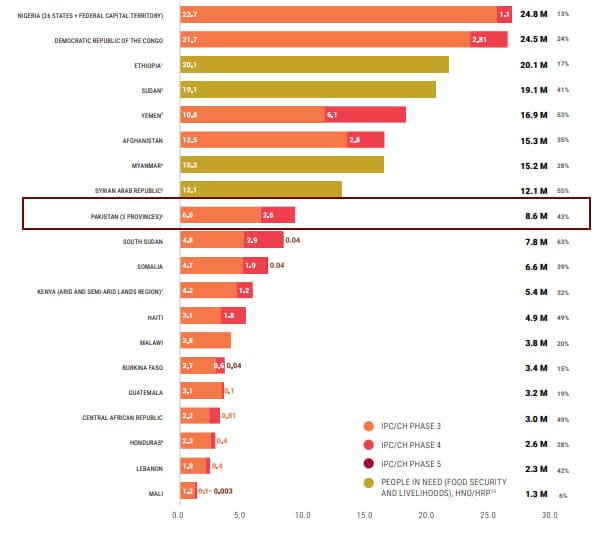Pakistan, the Central African Republic, Ethiopia, Kenya, the Democratic Republic of the Congo, and the Syrian Arab Republic are ‘hotspots with deteriorating critical conditions’.
According to the United Nations report, ‘Hunger Hotspots FAO‑WFP early warnings on acute food insecurity’, all these hotspots have a high number of people facing critical acute food insecurity, coupled with worsening drivers that are expected to further intensify life‑threatening conditions in the coming months.
The deterioration of acute food insecurity in the hunger hotspots occurs in the context of a global food crisis. As a result, the countries and situations covered in this report highlight the most significant deteriorations of hunger expected in the outlook period but do not represent all countries with high levels of acute food insecurity.
A likely worsening of the economic and political crises could further reduce households’ purchasing power and ability to afford food and essential goods in Pakistan, where 6 percent of the rural population across the 43 districts analyzed are assessed to be in an emergency between April and October 2023.
Acute food insecurity is likely to further deteriorate in Pakistan over the coming months, if the economic and political crisis further worsens, compounding the effects of the 2022 flooding.
Mounting public debt amid the current global economic slowdown has exacerbated the ongoing financial crisis. Authorities will have to repay USD 77.5 billion of external debt between April 2023 and June 2026, a substantial amount considering a GDP of USD 350 billion in 2021. Growing political instability and lagging reforms prevent the release of a crucial new credit line from the International Monetary Fund and additional support from bilateral partners.
The political crisis and civil unrest are likely to worsen ahead of general elections scheduled for October 2023, amid growing insecurity in the northwest. Shortages of foreign reserves and a depreciating currency are diminishing the country’s ability to import essential food and energy supplies, driving steadily increasing food inflation and causing nationwide energy cuts.
The situation is compounded by the effects of devastating floods between July and September 2022, which caused damages and economic losses to the agriculture sector estimated at USD 30 billion.
Over 8.5 million people (43 percent of the analyzed population of 19.8 million) were likely to experience high levels of acute food insecurity (IPC Phase 3 or above) between September and December 2022. Food insecurity and malnutrition within and beyond the analyzed regions are likely to deteriorate in the outlook period, as economic and political crises are reducing households’ purchasing power and ability to afford food and essential goods.





























